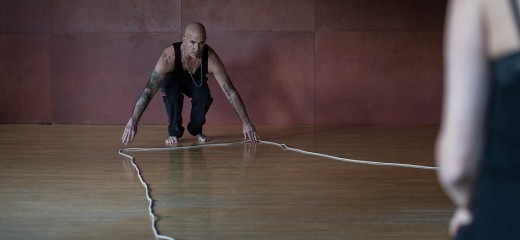
Taking Off from Anna Halprin’s Dance Deck: Ally at the Fabric Workshop and Museum
by Jonathan Stein
Ninety-five-year-old Anna Halprin is the great grandmom of post-modern dance. For over sixty years, twentieth-century dance and performance innovators such as Merce Cunningham, Simone Forti, Trisha Brown, and Yvonne Rainer have been playing and inventing with Halprin on her outdoor dance deck in Marin County, California. “When you reach up in a room, psychologically you go as far as the roof; outside, you go as far as the sky,” Halprin told a writer on her ninety-fifth birthday tribute last year.
Halprin’s most recent dance deck-mates have included Janine Antoni and Stephen Petronio, two artists who have worked together on eight projects; she is the guiding spirit of their intergenerational collaboration and four-floor exhibition of live dance, sculpture, installation, and video at the Fabric Workshop and Museum (FWM) through July 31.The result is Ally, a rich and multi-layered exhibition of art and performance that the FWM describes as conceived and performed by Antoni in collaboration with Petronio and Halprin.
Petronio confessed over lunch at the press preview that he knew Halprin initially only as a historical figure (par for the course in the New York-centric dance world); Antoni, a sculptor who has long plumbed the psychological, religious, and metaphysical meanings of the body and who relishes “taking the ephemeral into art spaces,” only discovered Halprin through the first biographical feature film about her, Breath Made Visible (2009) by Ruedi Gerber. Antoni says she “was blown away” by Halprin’s life and career, and, as she told me, soon after seeing the film, she rushed out to a West Coast workshop with Halprin (and she will also head west to work with her at the close of this exhibition). For a year, Antoni withheld from Halprin the fact that she was an artist and considering a mid-career retrospective. When she finally asked Halprin to make a dance for her, Halprin instead chose to have Antoni, who had never danced in performance, become the dancer. As Antoni has related in Artforum, “of course, anyone could be a dancer to her! She knew immediately what she wanted me to do. ‘You have to work with paper. And maybe you’d like to take off your clothes.’”

Antoni was ambivalent about having a retrospective that looked primarily backwards, perhaps sharing the sentiments of the Ed Ruscha drawing, I DONT WANT NO RETRO SPECTIVE (1967). But like Xavier Le Roy, who, by focusing on art as a living process, and the exhibition format becoming a creative medium, re-invented the retrospective convention in his Retrospective at MoMA PS1 in 2014, Antoni, too, has used the opportunity to create a collaborative, multi-disciplinary art project to show, as she told a preview audience, “how everything in life is connected, stays in process and has malleable meanings.”
Paper Dance
The audience enters to sit upon any of three dozen art-packed crates of Antoni’s prior sculptures—derrieres on pedestals—a hint at the artist’s sly humor for her retrospective. For each of her twenty solo performances of Paper Dance, Antoni first unpacks one and repacks another art object, untitled for the audience . These have included the set of photos, Mom and Dad (1994), a hybridized family portrait where each parent is made up to look like the other, and the surreal cast-resin sculpture, to channel (2015), juxtaposing a skeletal pelvis atop an overturned human head on an overturned flowerpot base.
Shortly before her improvised duet with a long length of brown paper, and again at the close, Antoni projects on the gallery wall or the side of an art crate film excerpts from Halprin’s Stockholm performance of Parades and Changes (1965), which includes a section also called Paper Dance, a massing of nude dancers tearing and cascading through paper. (After a later one-time performance of the piece in New York City, Halprin reportedly skipped town to avoid an arrest warrant for nudity.)
a body? a mole? squiggles and tunnels back unseen under the long brown earthen sheet
curly head popping out at one end
folding and molding, a chrysalis wriggling out of the torso cast
she lies like the Rokeby Venus next to this surrogate paper body
behind her, photos of Mom and Dad, who is Mom? who is Dad? which Venus do we see?
paper, a low-hanging cloud obscuring face and head, revealing a half nude body
paper, becoming a Ziggurat, a Gehry off its moorings, revolving into a whirlwind,
bringing cooling breezes from Anna’s deck into our space
paper, pulled out from between splayed legs, borne into uncertain times
ripped, gathered, discarded, silent.
*
Rope Dance and video of Anna Halprin
This improvised performance was initiated by Halprin when she met Antoni and Petronio at her studio in 2014 and presented them with a rope to connect them and serve as an improvisational tool. The dance here evolves from a blindfolded solo by Antoni, walking on lengths of rope on the floor, to a contrapuntal duet with Petronio, rope around his head, connected to her waist and shoulder. Then, in a nod to Halprin’s at-the-time radical ideas of participatory, collective ritual, expanded at the FWM to include the audience. The piece has the serendipitous feel of early task dances of the ’60s and ’70s (most recently seen here in the Trisha Brown festival in a re-setting at Bryn Mawr College of Floor of the Forest [1970] with dancers navigating a roped platform draped with used clothing).
Before Rope Dance and after, we see a video on the wall of only Anna Halprin’s face while she views, unseen to us, the Rope Dance by Antoni and Petronio on her dance deck.
all senses in your feet, seeking your way on the rope, no GPS here,
your toes meet that junction of two ropes, like nostrils sniffing two scents for direction,
you join your twin, tethered together, marking Sol Lewitt lines in space
and now our turn, Steve the drawing master, guiding us to be ‘gentle and continuous’ and to ‘move slowly, eyes closed.’
Anna is watching all, breath blown through lips in excitement,
that overhead jet doesn’t distract you,
joy in your head shifting back, a guffaw, a scratch of your nose
witnessing becomes the performance
the maker, the creator, revealed, no longer unsung.
*

Swallow
Antoni roots her art in the body process and performance work of ’70s feminist artists like Hannah Wilke and Ana Mendieta: “the humor, the process, the emphasis on performance, the intensely visceral quality of their work,” says Antoni. For this exhibition, last fall Antoni and Petronio together swallowed, from each end, equal lengths of a 10 foot long, 3- to 4-inch wide, gauze fabric, woven at the FWM. This was seen in New York by only ten audience members selected from different professions and backgrounds: marriage counselor, lawyer, specialist in swallowing disorders, Klein somatic therapist, subway worker. Expecting to see the usual museum or gallery documentation of ephemeral performance in fixed-point video or photographic representation, I was delightedly surprised to find that we experience this ritualistic performance via audio recollections in the multiple voices of the witnesses, heard (although not always clearly) under ceiling-hung speakers while I sit, with another audience member, in one of two chairs joined at their corners, Antoni's variant of 19th Century tete-a-tete or gossip chairs. (Excerpts are below.)
At one end of the same gallery was an elegant gold-plated bronze sculpture with two spine-like esophagi, miniature Solomonic columns emerging from a diaphragm, topped by what might be a larynx. Above are two-chambered blown-glass vessels, cheeks or lung-like cavities, each containing half of the rolled ten-foot cloth. One could look down through an ornate wishbone-shaped aperture (modeled after an epiglottis) and magnifying glass to spy the fabric at the point when Antoni and Petronio met. The spot-lit sculpture becomes a reliquary, anatomy entombed, and a sacred scroll preserved. At the other end of the gallery is a sealed glass vitrine with an image on a fabric printed with saliva and graphite of Antoni and Petronio near the climax of Swallow. Housed in the vitrine are hundreds of moths, expected to ingest and degrade the image. As of last visit, the moths, appeared dead , but are reported only to be in a dormant part of their cycle, still intended, with the assistance of their entomologist handlers listed in the credits to the show, to fulfill their art mission.
The Listener: “mutual swallowing, like a pair of lovers, a process of infatuation turning to intimacy as they become closer... last few inches practically a kiss, two I’s become a we, then breaking apart.”
The Healer: “beautiful and ritualistic in the beginning, more gagging on way out, gross, gut-wrenching at end… Janine’s struggle, perseverance was beautiful…. Petronio, very grounded through his body, had an advantage in swallowing.”
The Poet: “romantic, touching, endearing… re-thinking purpose of swallowing… gauze as a surrogate for language, it is the unspoken… another form of intercourse, sharing material and understanding.”
The Mender: “swallowing is nutrition, nurturing, love, affection… it’s not safe to be talking while swallowing.”
Mother and Twins: “sex, going into your gut, unconnected to words, breathing, like two people inside you negotiating space inside… one very young twin (heard to say), meshuga.”
The Defender: “how memory gets affected for witnesses at a trial… he remembers his Epsom-salt baths as a child, soothing and disgusting… tension between competition and cooperation… a boa constrictor, a predator slowly getting it down… Janine struggled to get it down.”
*

The Courtesan and the Crone
When Petronio met with Halprin to obtain one of her solos for this exhibition, he related that he had in mind a muscular, athletic work that would play to his physical virtuosity. Instead, Halprin offered him a solo she created for herself in 1999, at age 79, a short dance of seduction with minimal action where a Venetian-masked seductress in a golden brocade gown reveals herself to be an aged woman. Making this piece his own, Petronio adds highly dramatic elements of lighting and a red theater-curtain backdrop; when unmasked, instead of hidden age, we see hidden sex.
emerging from blinding lights, a ghostly courtesan
impenetrable smile perching on high heels
a flick of a white gloved hand, a glimpse of a bared leg
the man who knows no gender
disappears again into shadows against the wall
Ally, Janine Antoni, Anna Halprin and Stephen Petronio, The Fabric Workshop and Museum, April 21–July 31, www.fabricworkshopandmuseum.org (Don’t be deterred by Sold Out performances,). Previously: tD’s Ellen Chenoweth has interviewed Adrian Heathfield who has collaborated on Ally and is editing a book emerging from work.
Images used in this essay are courtesy of the artists and The Fabric Workshop and Museum, Philadelphia. The home page photo is by Carlos Avendaño, and the photo above is by Hugo Glendinning.
By Jonathan Stein
May 22, 2016

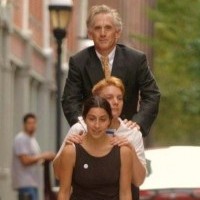
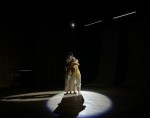
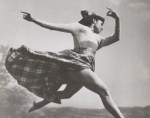
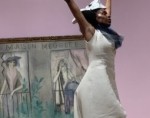



.png)


